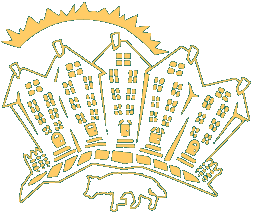In our city?
Coyotes are an extremely adaptable wildlife species that survives well in urban environments — including our city.
Coyotes are relatively new to the Lower Mainland, but have lived in large cities like Calgary and Los Angeles for many years.
Not in my neighbourhood!
Coyotes are often sighted on local golf courses and in parks, but they can be found in most GVRD neighbourhoods — including yours!
Why are they here?
Many people believe coyotes are in the Lower Mainland because we have "taken over their habitat." Actually, we often create habitat for this generalist species, when we cleared forested land for housing.
What do they look like?
They look much like a cross between a fox and a small collie or German Shepherd.
Coyotes in the Lower Mainland weigh between 9 - 14 kg. They often appear heavier than they actually are due to their thick double coat. Coyotes have bushy tails which they hold low when running. They have narrow delicate noses and relatively large ears.
Although there is variation in colour, coyotes appear a grizzled reddish yellow colour. They have darker grey and black hairs on their upper body and lighter cream-coloured undersides.
How many?
Contrary to some news reports, there are probably only between 2,000 and 3,000 coyotes in the whole Lower Fraser Valley and perhaps 200 in the Greater Vancouver area.
What do they eat?
Coyotes eat a variety of foods. In rural and wild environments, up to 70% of a coyote's diet consists of small mammals (mice, voles, rabbits, etc.) the rest is a combination of fruits, vegetables, insects, garbage and other available items.
In urban areas, such as the Lower Mainland, coyotes also prey on rats, squirrels, raccoons, opossums, Canada geese, ducks and domestic pets (especially cats and small dogs).
When are coyotes most active?
Coyotes can be active both day and night.
Coyotes are born in the spring, and food requirements of the nursing females and growing young are very high at this time of year.
Also at this time people and their pets spend more time outdoors as the weather becomes warmer.
Therefore, the potential conflict at this time increases. Please be aware of the potential risk to your pets.
What about rabies?
This is not currently a safety concern. To date, rabies has not been found in any BC coyote population.
Are coyotes a risk to people?
Coyotes are rarely if ever a risk to people, They are curious but timid animals and will run away if challenged.
In the only reported incident in the last two years in the GVRD where a coyote has bitten a human, the coyote had been fed by well-meaning but misguided individuals.
Feeding coyotes can cause them to lose their natural fear of people and become dependent on handouts. So please don't feed them.
What to do if approached
If someone is approached by a coyote, they should make themselves appear larger (stand up if sitting) and act aggressively by waving arms, throwing stones and shouting.
Any of these should send the coyote packing.
Coexistance the best choice
Trapping coyotes in the city is very difficult and ineffective. Poisoning programs to reduce coyote numbers would also kill other wild animals. In the city, these poisons could also be a risk to pets and children.
It is not surprising these methods are socially unacceptable in today's society.
Relocation is often suggested as an alternative. This simply moves the problem coyote to someone else's backyard. It can also put a coyote at risk by placing it in another coyote's home range or territory. In addition, when you remove one coyote it may be replaced by one or more in the same area.
Coexistance with this interesting wild species seems to be the best option simply because coyotes are difficult to trap and both eradication and relocation programs in other parts of North America have proven both ineffective and very expensive.
Things you can do…
-
Keep pets under your control (dogs and cats on leash when outside).
-
If you must let your pet out unattended, provide a secure space for it to exercise (such as an enclosed cat or dog run).
-
Never feed coyotes. Our best defence is not to habituate or get them used to people. We need to keep them wild. This is one of the best way to protect our pets.
-
Be careful not to feed coyotes unintentionally. For example they are attracted to:
-
improperly contained garbage
-
open composts containing fruit or vegetables
-
fruit that has fallen from trees and is left on the ground
-
an overflowing bird feeder (they'll eat the grain as well as the small mammals this food attracts)
-
pet food, so never feed pets outdoors
-
Fencing helps discourage them from entering your yard. Make sure fences are flush to the ground and in good repair.
Coyotes are only one risk facing the outdoor pet, consider making your cat or dog an indoor animal.
A fed coyote is a dead coyote
Coyotes are industrious animals quite capable of surviving in the city without our help. In fact, by feeding coyotes you put yourself and the coyote at risk.
A coyote that becomes dependent on humans for food, may become too bold, bite someone and have to be destroyed.
Please don't feed any wildlife, especially coyotes — enjoy them from a distance.
For more information
-
Urban Coyote Video – available from the Urban Wildlife Committee, Delta Cable, or the BCSPCA Education Dept.
-
Urban Coyote Kit – an educational kit for school kids and interested adults! Contact the BCSPCA Education Dept.
-
Coyote Homepage at:
www.interchange.ubc.ca/kwebber/
Brought to you by:
Urban Coyote Project
Supported by:
Minstry of Environmental Lands and Parks; BCSPCA; SPCA Vancouver Branch; BCSPCA Education Department; Urban Wildlife Committee; City of Vancouver; UBC Department of Animal Science; Stanley Park Ecological Society; Cheryl's Pet Taxi


![[Previous]](../previous_off.gif)
![[Next]](../next_off.gif)